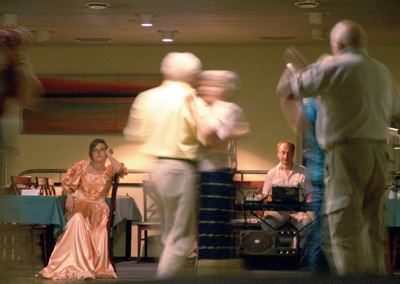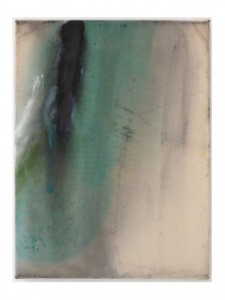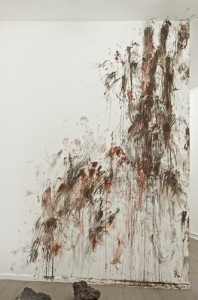
Over the last few decades, the international art scene has moved to Berlin. En masse. Inspired by cheap rents, massive spaces, and a high quality of life. But also by the plethora of myths of old and new. The city appears to be home to more art magazines and blogs, galleries and artists than the rest of Europe taken together. In recent years, exciting new galleries such as Galerie Tanja Wagner, Galerie Torstrasse 161, PSM gallery, Galerie Barbara Weiss, Soy Capitan, and Pool Gallery have popped up around the city. They host young and promising artists like Sejla Kameric, Cyprien Gaillard, Nina Canell, Julieta Aranda, Amy Stein, Nina Konnema, Nathalie Djurberg, Guido van de Werve, Armin Boehm, Isabelle Fein, Mariechen Danz, Susanne Burner, and Oystein Aasan.*
Together, these galleries and artists form the Young Berlin Artists. Yup, the YBAs.
The YBAs have at once everything to do with the former Y and now O(ld)BAs and nothing. Like those elderly British Artists once, they tend to be in their twenties and early thirties. Like the OBAs also, they represent a new, if not paradigm, than at least discursive attitude towards making art which is as much a reaction to previous artistic traditions as it is a response to a particular socio-economic context. And like the erstwhile position of the OBAs, the attitude of the YBAs is particularly pronounced in one place (Berlin), but is noticeable elsewhere in Germany, Europe, the world, as well: in galleries like Parisa Kind in Frankfurt, Galerie Desaga in Dusseldorf, Upstream in Amsterdam, Maureen Paley and Raven Row in London; in the works of artists such as Ragnar Kjartansson, Pilvi Takala, Monika Baer, David Thorpe, Silas Schletterer, Frauke Boggasch, and Alexandre Singh. Indeed, like the ‘British’ in OBAs, the ‘Berlin’ in YBAs should be understood as a genius more than a locus, a spirit more than a place.If we are to believe the OBAs, the art world in the eighties was something of a dictatorship. When they began congregating, they had to meet clandestinely, in scruffy South London art schools, squatted East London warehouses and at self-organised group exhibitions. Publicly exposing their work, so they tell us, meant nothing less than a revolution. Today, the art world is still pretty despotic, with the MOMAs and the TATEs, the BaselIs and BaselIIs, the Gagosians and the White Cubes, Art Forums and Art Reviews, determining the rules. Yet the blogosphere, social media, the rise of the BRICS, and, in Berlin at least, cheap rents, have created spaces beyond their rule of law. The YBAs might still not instantly get to exhibit in the TATE or Gagosian, but they do not have to overturn the system to be able to expose their work publicly. From Younger than Jesus at PS1 in 2009 to the controversial Based in Berlin across Berlin right now, from the new galleries and projects initiated by young gallerists and curators to online fora and auctions – there are spaces. Back in the day, the OBAs had to resort to polemics at best and de-politicised provocation at worst in order to be noticed. The YBAs, in contrast, can be personal and intimate and still reach an audience.
 It is here that the YBAs differ most from the OBAs. The OBAs, Damien Hirst, Tracey Emin and Cindy Sherman especially, represented that strand of postmodernism that has been called, it we leave out the currently popular tag obnoxiousness, cynicism, abstract conceptualism, or deconstruction. The attitudes expressed by the YBAs, however, are what we on this blog have come to call metamodernism. It is an attitude that oscillates between a modern enthusiasm and sincerity and a postmodern irony; between grand narratives and personal life stories; between science and mysticism; between critical distance and affect; and between concepts and craftwo/manship. It is an attitude that says, as Jerry Saltz, of all people, once put it: “I know that the art I’m creating may seem silly, even stupid, or that it might have been done before, but that doesn’t mean this isn’t serious.” It is an attitude also that says, following the legacy of that increasingly important artist Bas Jan Ader, “I know I will fail, but that is the point: to try in spite of”.
It is here that the YBAs differ most from the OBAs. The OBAs, Damien Hirst, Tracey Emin and Cindy Sherman especially, represented that strand of postmodernism that has been called, it we leave out the currently popular tag obnoxiousness, cynicism, abstract conceptualism, or deconstruction. The attitudes expressed by the YBAs, however, are what we on this blog have come to call metamodernism. It is an attitude that oscillates between a modern enthusiasm and sincerity and a postmodern irony; between grand narratives and personal life stories; between science and mysticism; between critical distance and affect; and between concepts and craftwo/manship. It is an attitude that says, as Jerry Saltz, of all people, once put it: “I know that the art I’m creating may seem silly, even stupid, or that it might have been done before, but that doesn’t mean this isn’t serious.” It is an attitude also that says, following the legacy of that increasingly important artist Bas Jan Ader, “I know I will fail, but that is the point: to try in spite of”.
In previous posts I as well as others have discussed metamodern art in terms of the artistic oscillations between optimism and pessimism, sincerity and irony, and affect and disinterest, as well as in relationship to larger ecological, economical, political, social and cultural changes. Two other rather ‘Berlinesque’ oscillations are those between politics and the personal, and technology and techne.
Works of artists like Kameric, Van de Werve, Takala, Singh, and Gaillard, seem to be equally concerned with politics, that is, with atopias, with the public sphere, with capitalism, with collective responsibility, with shared memories, with massacres, and with the ways in which we shape our material world; and personal poetics, the aesthetic and often affective exploration of personal dreams, desires and histories. Kameric, for instance, negotiates between her personal dreams and the collective nightmares of the Bosnian past. Gaillard appears to negotiate between a personal fetish and the truth of historical Reason. And Takala probes the tension between social structures and personal experience. What is of interest is that these artists do not extract public issues onto a private scale (a la the moderns). Nor do they exhibit their personal concerns and quirks onto a public stage (comme the postmoderns). On the contrary, they imagine the public space as if it were their private sanctuary. Kameric invites us into the glocal spaces of displacement and discrimination as if they were rooms in her own home. Gaillard guides us through modernist housing projects as if he gave us a tour of his house, attaching as it were to each flat a familial memory, imbuing each alley with a personal anecdote.
Another oscillation that has become increasingly manifest of late is that between technology and techne. For a while during the nineties, any number of artists appeared to be so overjoyed/confused/terrified by technological advances that their art became entirely technological. For some, that meant that their art should explore the nature of technology; for others, that meant that their art should examine the notion of technology; for yet others, the ethics, etc. But mostly, technological meant to be mathematical, to be digitally produced and reproducible, and to be conceptual. For artists like Hirst and Emin, the idea behind the work was more important than the idea of the work. Over the last few years, however, technology’s older relative, techne, ‘knowledge’ and value through practice, has returned.
Artists like Paula Doepfner, Burner, Stein, Konnema, Kjartansson, and Schletterer are as interested in the ideas behind their work, as they are appreciative of the experience, exercise, effort, performativity (Nancy’s excription, perhaps), paint, pastures, penciling, textures, canvas, clay, talent, love, and so on and so forth, that goes into making it. Whether one describes this return to techne in terms of the process, as Boris Groys has recently in Frieze DE, or as materialist, as Vanessa Thorpe has just in The Guardian is besides the point. What matters is that in it, the hegemony of the concept is questioned. What matters, what matters more even, is that it that the tools they use for deconstruction can also be put to task of reconstruction. At her latest show at Galerie Tanja Wagner, Doepfner painted the walls with thick, multilayered, uneven, rhizomatic lines. But she was not simply trying to deconstruct the rules of (re)presentation. On the contrary, what she tried to do was construct new ones.
Of course, I have exaggerated the positions of the OBAs, and generalised the attitudes of the YBAs. I don’t know, moreover, whether the YBAs will stay ‘Berlinic’. As the Internet is increasingly regulated, and Berlin real estate prices soar, there is a real possibility these disciples of Ader, Doig and Hatoum will turn to Hirst for advice. But what I have tried to describe here is a change of attitude that is enabled by a democratisation of the art world and informed by deterritorialisation of the ecological, economical and political world. Artists today, in Berlin and elsewhere, are trying to find a new language in order to come to terms with climate crisis and credit crunch, political instability and personal uncertainties. In trying to find that language, they turn, firstly, to themselves: after a generation often described as indifferent, they anew engage themselves with the events, people, things around them; and after a generation described as consumerist, they anew begin to produce.
Images from top to bottom: Pilvi Takala, Wallflower (2006), Courtesy Artist; Frauke Boggasch, Untitled (2009), Courtesy Galerie Desaga; Paula Doepfner, Damn it (2010), Courtesy Galerie Tanja Wagner.
* I would like to thank Ovul Durmusoglu for her insights regarding the Berlin artists.


I think disengagement is a new base form of a serious creative process that shapes the real post-hipster vanguard of today.
Pingback: What is metamodernism? | Notes on Metamodernism